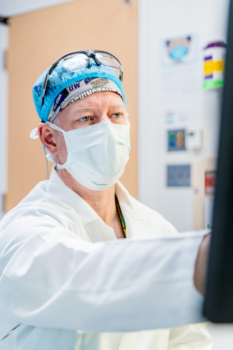
March is Cerebral Palsy Awareness Month. Cerebral palsy is a condition that causes differences in how someone moves and controls their muscles. The differences are caused by an injury to a child’s developing brain. The brain injury can happen before, during or after birth. The injury does not change (it is non-progressive), but the effects can change over time and worsen as children grow. The condition affects a child’s strength, muscle tone and motor control.
According to the U.S. Centers for Disease Control and Prevention, cerebral palsy is the most common motor disability of childhood and approximately 1 in 345 children have been identified with the disorder.
The Cerebral Palsy Program at Seattle Children’s features a team of providers, surgeons and therapists with expertise and experience treating children, teens and young adults with cerebral palsy.
The program brings together pediatric experts from multiple specialties to evaluate and treat a patient’s unique needs. These specialties include:
- Neurodevelopmental
- Neurology
- Neuropsychology
- Neurosurgery
- Occupational Therapy
- Orthopedics and Sports Medicine
- Orthotics and Prosthetics
- Physical Therapy
- Rehabilitation Medicine
- Speech and Language Services
- Tone Management Program
One procedure to treat spasticity in children with cerebral palsy is a Selective Dorsal Rhizotomy (SDR), a surgery performed to reduce spasticity (high muscle tone) in the legs of children. The goal is to relax certain muscles by identifying and cutting only the nerve fibers that contribute to spasticity. This procedure is offered by the Tone Management Program.
Dr. Samuel Browd, surgical director and neurosurgeon for the Cerebral Palsy and Tone Management Programs at Seattle Children’s, spoke with On the Pulse to provide more information on this procedure.
In layperson terms, how do you describe SDR surgery?
SDR is neurosurgical procedure where we cut specific portions of nerve roots that cause spasticity in kids with cerebral palsy and other conditions. We are able to test all the nerves going to the legs and select those nerves that have abnormal behavior and cut them. The decision to cut is based on the child’s exam, which muscles are affected, and the intraoperative electrical monitoring that is done to test the nerves during surgery.
By cutting some of these abnormal nerves, we allow the brain and spinal cord to rewire or undergo “neuroplasticity” after the procedure using physical therapy and rehabilitation to drive the development of new neuronal pathways that support improved gait and function.
Why and how does this improve quality of life for people with cerebral palsy?
Quality of life is dramatically improved with SDR. The ability to reduce the high muscle tone leads to many benefits for the kids. They are able to move easier, their stamina is improved, and they are better able to manage their body movements. Besides the commonly reported outcome of reduced muscle tone, we see so many amazing benefits that are rarely mentioned in our medical literature. Kids seem to often do better in social settings. For example, they are falling down less, they have an easier time using the toilet, and we often hear reports that they are doing better in school. This is not because of the surgery, but because the surgery allows them to move easier, have better balance and they can then focus their brain energy on learning versus trying to control a body that is fighting back because of the tone they can’t voluntarily control.
Why is the surgery relatively rare? What would you like to see change in terms of awareness about SDR?
SDR surgery is commonly an option for kids with spasticity and can lead to reduction or elimination of the need for medications to treat increased tone. There has been a long history of treating kids with only medication and physical therapy, and surgery sounds scary to parents and some providers, so we often don’t get the opportunity to evaluate kids until they are older. The sweet spot for surgery is younger kids starting at about 4-5 years of age. We would love to see all kids with cerebral palsy and high tone get evaluated for an SDR. While it is not appropriate for all kids, knowing treatment options to make good decisions about care is our goal as we educate our patients and families about SDR.
The Tone Management Program at Seattle Children’s offers medical and surgical evaluation services to determine whether a patient could benefit from the SDR surgery. Children with spasticity or dystonia – from conditions like cerebral palsy, spinal cord injury or traumatic brain injury – may move more easily and feel more comfortable if they have treatments that control muscle tone.

